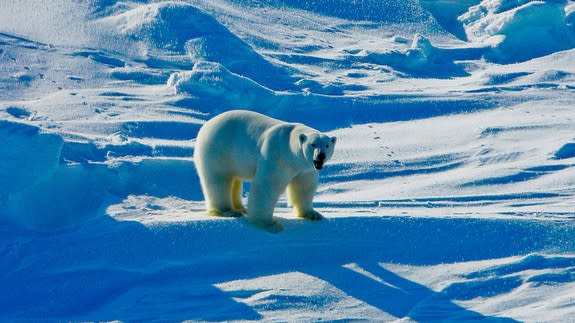Humans will drive polar bears to extinction without climate action, feds say

Polar bears will disappear from the Arctic if the U.S. and other nations don't drastically reduce their greenhouse gas emissions soon, U.S. wildlife officials warned this week.
The bears' sea-ice habitat is steadily shrinking due to human-driven global warming. That makes curbing emissions the "single most important action" to protect the species, the Fish and Wildlife Service (FWS) said in a new report.
SEE ALSO: Portland's polar bear plays in the first snow of the season
"Make no mistake; without decisive action to address Arctic warming, the long-term fate of this species is uncertain," Greg Siekaniec, the FWS's Alaska regional director, said Monday in a news release.
The federal report is the latest piece of bad news for polar bears. A separate study last week found that toxic pollutants moving into the Arctic from outside the region are accumulating in mother bears' breast milk and getting passed on to their cubs.

Image: Tierpark Berlin/picture-alliance/dpa/AP Images
The report also arrives at a particularly uncertain time for U.S. climate and energy policy.
President-elect Donald Trump and many of his cabinet nominees reject the mainstream scientific consensus that humans are driving climate change. For example, Trump's pick for the Environmental Protection Agency — the department responsible for regulating carbon emissions — has vowed to gut many of the EPA's climate policies.
Meanwhile, Arctic sea ice is plummeting, hitting record lows.
Most recently, in October and November 2016, the area of the Arctic covered by sea ice was the lowest on record for those months since record-keeping began in 1979, according to the National Snow & Ice Data Center.
Again, no, #Arctic sea ice not recovering. Extent/thickness/volume of ice are all the lowest on record for the date as we start 2017... pic.twitter.com/AGKC2Q8T1V
— Zack Labe (@ZLabe) January 10, 2017

Image: Sputnik via AP
Polar bears were listed as threatened under the Endangered Species Act in 2008 due to the continued loss of their sea-ice habitat. The species depends on the floating ice as platforms for hunting seals, their primary source of food.
The FWS is required under the act to produce a report — called a conservation management plan — that describes what actions are needed for the species to recover and avoid extinction.
Around 26,000 polar bears currently make up 19 subpopulations in parts of five countries: the United States, Canada, Russia, Norway and Greenland. The FWS report mainly focuses on two subpopulations off the coast of Alaska, in the southern Beaufort and Chukchi Seas.
While the global polar bear population hasn't yet shown a precipitous decline, certain subpopulations have started to drop, including in the southern Beaufort Sea. The number of bears there has dropped about 40 percent in the last decade, from 1,500 bears in 2006 to about 900 today, according to the report.
"If greenhouse gas emissions continue to rise at the current rates throughout the 21st century, polar bears will likely disappear from much of their present-day range," the agency warned.

Image: Brian Battaile/U.S. Geological Survey via AP
Along with curbing emissions, the FWS's conservation plan also calls for reducing human-bear conflicts, protecting the dens of pregnant polar bears and minimizing the risk of contamination from oil spills.
For some environmental groups, however, the report doesn't go far enough.
The Center for Biological Diversity said the recovery plan was "weak" and should have required the U.S. to make the large-scale emissions reductions needed to save the species.
"This recovery plan is just too risky for the polar bear,” Shaye Wolf, the center's climate science director, said in a statement.
"Recovery plans work, but only if they truly address the threats to species. Sadly that simply isn't the case with this polar bear plan."

